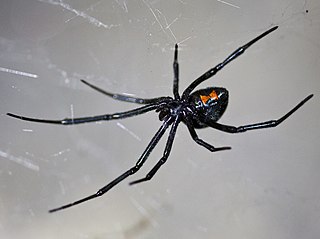Stridulation is the act of producing sound by rubbing together certain body parts. This behavior is mostly associated with insects, but other animals are known to do this as well, such as a number of species of fish, snakes and spiders. The mechanism is typically that of one structure with a well-defined lip, ridge, or nodules being moved across a finely-ridged surface or vice versa, and vibrating as it does so, like the dragging of a phonograph needle across a vinyl record. Sometimes it is the structure bearing the file which resonates to produce the sound, but in other cases it is the structure bearing the scraper, with both variants possible in related groups. Common onomatopoeic words for the sounds produced by stridulation include chirp and chirrup.

Latrodectus is a broadly distributed genus of spiders with several species that are commonly known as the true widows. This group is composed of those often loosely called black widow spiders, brown widow spiders, and similar spiders. However, the diversity of species is much greater. A member of the family Theridiidae, this genus contains 34 species, which include several North American "black widows". Besides these, North America also has the red widow Latrodectus bishopi and the brown widow Latrodectus geometricus, which, in addition to North America, has a much wider geographic distribution. Elsewhere, others include the European black widow, the Australian redback spider and the closely related New Zealand katipō, several different species in Southern Africa that can be called button spiders, and the South American black-widow spiders. Species vary widely in size. In most cases, the females are dark-coloured and can be readily identified by reddish markings on the central underside (ventral) abdomen, which are often hourglass-shaped.

The Pholcidae are a family of araneomorph spiders. The family contains more than 1,800 individual species of pholcids, including those commonly known as cellar spider, daddy long-legs spider, carpenter spider, daddy long-legger, vibrating spider, gyrating spider, long daddy, and angel spider. The family, first described by Carl Ludwig Koch in 1850, is divided into 94 genera.

Amaurobiidae is a family of three-clawed cribellate or ecribellate spiders found in crevices and hollows or under stones where they build retreats, and are often collected in pitfall traps. Unlidded burrows are sometimes quite obvious in crusty, loamy soil. They are difficult to distinguish from related spiders in other families, especially Agelenidae, Desidae and Amphinectidae. Their intra- and interfamilial relationships are contentious.

The spider genus Steatoda, in the family Theridiidae, includes about 120 recognized species, distributed around the world. One common name is cupboard spider, for many species build their webs in dark, sheltered, undisturbed places around the house or garden, in sheds and garages, under garden, in compost bins, and the like. Signs of the cupboard spider include small white spots of spider droppings, like small splashes of paint, on the floor underneath the web.
A latrotoxin is a high-molecular mass neurotoxin found in the venom of spiders of the genus Latrodectus as well as at least one species of another genus in the same family, Steatoda nobilis. Latrotoxins are the main active components of the venom and are responsible for the symptoms of latrodectism.

Steatoda grossa, commonly known as the cupboard spider, the dark comb-footed spider, the brown house spider, or the false widow or false black widow, is a common species of spider in the genus Steatoda.

The triangulate cobweb spider is a common spider in the genus Steatoda. It is well known for the triangle-shaped pattern on the dorsal side of its abdomen.

Steatoda nobilis is a spider in the genus Steatoda, known in the United Kingdom as the noble false widow, as it superficially resembles and is frequently mistaken for the black widow and other spiders in the genus Latrodectus. It is often referred to as thefalse widow, although "false widow" is a more general term applied to a wider group of species with this resemblance.[a] It is a moderately medically significant spider, with most bites resulting in symptoms similar to a bee or wasp sting. Some bites may cause more significant harm, partly due to pathogenic bacteria from the spiders.

Amaurobius similis is a species of spider in the family Amaurobiidae. It is one of at least two common spiders found in houses known as lace-webbed spiders. The specific name similis is based on its similarity to the species Amaurobius fenestralis. Both are often found near windows, hence the specific name of A. fenestralis.

Amaurobius is a genus of tangled nest spiders that was first described by Carl Ludwig Koch in 1837.
This is a list of the known wild biota of the Isle of Man.

Amaurobius ferox, sometimes known as the black lace-weaver, is a common nocturnal spider belonging to the family Amaurobiidae and genus Amaurobius. Its genus includes three subsocial species, A. fenestralis, A. similis and A. ferox, all three of which have highly developed subsocial organizations.

Amaurobius erberi is a species of spider in the family Amaurobiidae, found in Europe and the Canary Islands.

Steatoda capensis is a spider originating from South Africa. Its common names include the black cobweb spider, brown house spider, cupboard spider and due to its similarities to the katipō spider it is commonly known as the false katipō in New Zealand. Common throughout Southern Africa, it has been introduced into other countries and is now present in Australia and throughout New Zealand. It is a small spider, usually an all-over shiny black. It may have a small bright red, orange, or yellow patch near the tip of the abdomen along with a crescent shaped band near the front of the abdomen.

Steatoda bipunctata is a species of cob-web spider, of the genus Steatoda, in the family Theridiidae.
Lace webbed spider, lace-webbed spider or lace-web spider may refer to:













